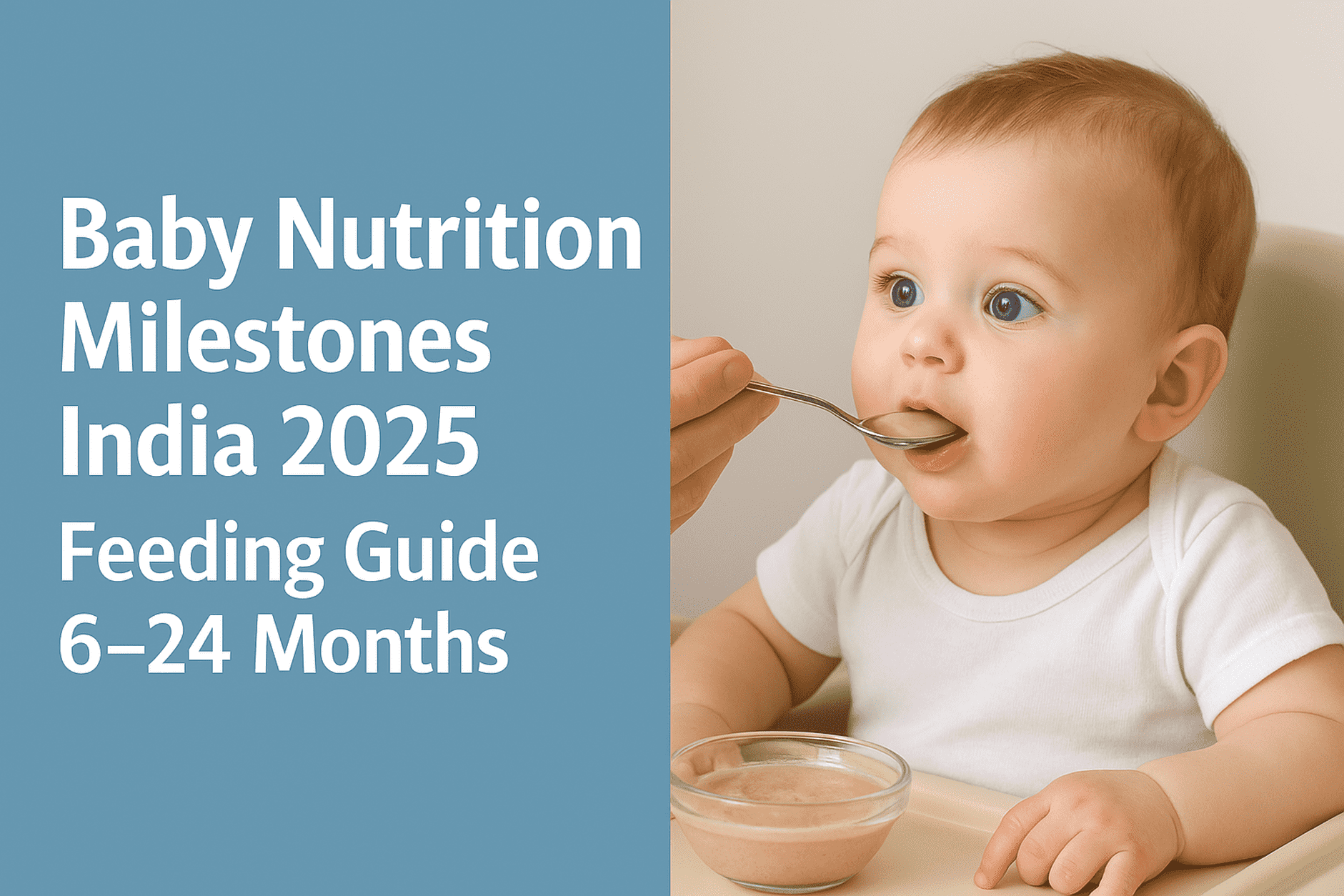Nutrition in the first two years shapes a child’s growth, immunity, cognitive development, and lifelong health. The right feeding practices can reduce infections, support proper growth, and make vaccinations more effective. If you’re already reading up on Baby Vaccination Schedule India 2025, you’re on the right path. This article complements that by focusing on what to feed your baby and when, in an Indian context.
Nutrition Needs by Age Milestones
0–6 Months
-
Exclusive breastfeeding is recommended. Breastmilk provides complete nutrition.
-
In special cases (e.g. insufficient milk), use formula under pediatric guidance.
6–9 Months
-
Continue breastmilk + begin complementary feeding.
-
Start with single-grain cereal (e.g. rice cereal), thin consistency.
-
Introduce pureed vegetables/fruits.
9–12 Months
-
Thicker consistency, mashed foods.
-
Introduce pulses, egg yolk, yogurt.
-
Increase variety of fruits/vegetables.
12–18 Months
-
Transition to family food (soft mashed).
-
Introduce small pieces of cooked vegetables, cereals, meats/legumes.
18–24 Months
-
More self-feeding with finger foods.
-
Balanced diet: grains, proteins, fats, dairy, fruits, vegetables.
What Foods to Introduce (and When)
| Food Group | When to Start | Notes & Tips |
|---|---|---|
| Grains / cereals | 6–8 months | Begin with single-grain, then mix (millet, rice, oats) |
| Vegetables & Fruits | 6–9 months | Start with mild ones (banana, apple, carrot, squash) |
| Proteins (legumes, pulses) | 9–12 months | Moong dal, soft lentils, dals, egg yolk |
| Dairy / Yogurt / Cheese | 9–12 months | Use pasteurized, full-fat options |
| Fats / Oils | 6–12 months | A bit of ghee, butter, or healthy oils in cooking |
| Finger foods / Textures | 9–12 months onward | Soft cooked veggies, small bits of bread, banana |
Sample Feeding Schedules & Portion Sizes
Example for a 9-month old:
-
Breakfast: Breastmilk + rice cereal with mashed banana
-
Mid-morning snack: Mashed fruit (apple / pear)
-
Lunch: Dal + soft vegetables + rice or khichdi
-
Evening snack: Yogurt / mashed papaya
-
Dinner: Similar to lunch
-
Before bed: Breastmilk or formula
Portion size idea (9–12 months)
-
Cereals / rice / khichdi: ~2–3 tablespoons
-
Vegetables / dal / pulses: ~2 tablespoons
-
Fruit / yogurt / milk: ~2–3 tablespoons
Adjust based on your baby’s appetite.
Common Nutrition Challenges & How to Handle
-
Picky eating: Offer small variety, repeated exposure, don’t force but gently encourage.
-
Food allergies: Introduce new foods one at a time and monitor for reactions.
-
Poor weight gain / undernutrition: Monitor growth charts; consult paediatrician early.
-
Overfeeding / obesity risk: Don’t force finish; avoid sugary processed snacks.
Safety Tips in Feeding
-
Choking risks: Avoid nuts, whole grapes, raw hard vegetables. Cut food into small, soft pieces.
For choking first-aid and emergency care, see Emergency Baby Care: Choking, Fever & First Aid
-
Food Hygiene: Wash hands, clean utensils, cook fresh food, avoid reheating repeatedly.
-
Avoid added sugar / salt: Infants don’t need extra sugar or salt.
Nutrition & Its Link to Immunity & Vaccination
A well-nourished baby has a stronger immune system, helping vaccines work effectively and reducing infections. Poor nutrition can lead to weakened response to vaccines. So feeding well supports your baby’s protection. (This connects to your vaccination schedule content.)
When babies cry often, hunger or discomfort may be one cause. If feeding issues or hunger signals seem to trigger prolonged crying, you may want to see Why Does My Baby Cry for No Reason?.
When to See a Pediatrician / Warning Signs
-
Baby consistently losing weight or not gaining
-
Persistent refusal to feed
-
Signs of dehydration (dry mouth, few wet diapers)
-
Blood in stool or vomiting after feed
-
Severe allergic reaction (hives, swelling)
FAQs
Q: When should I start complementary feeding?
A: Around 6 months, when baby shows readiness (sits with support, loses tongue-thrust reflex).
Q: How much milk/formula should a 12-month-old have?
A: 400–500 ml per day (including other dairy) is typical, but varies per child.
Q: Can I give cow’s milk at 1 year?
A: Yes, full-fat cow’s milk may be introduced after 12 months, along with solids.
Q: What if baby refuses vegetables?
A: Keep offering small amounts, mix with favorite foods, be patient — it takes multiple attempts.
Conclusion
Nutrition in the first two years lays the foundation for lifelong health. By following age-appropriate feeding guidelines, ensuring safety, and monitoring growth, you’ll help your baby thrive. You can strengthen this with vaccination, responsive care, and awareness of feeding challenges. Use this guide as a reference and always consult your pediatrician for individualized advice.
Reference :- WHO.
Disclaimer: This content was automatically imported from a third-party source via RSS feed. The original source is: https://drdad.in/baby-nutrition-milestones-india-2025/. xn--babytilbehr-pgb.com does not claim ownership of this content. All rights remain with the original publisher.



